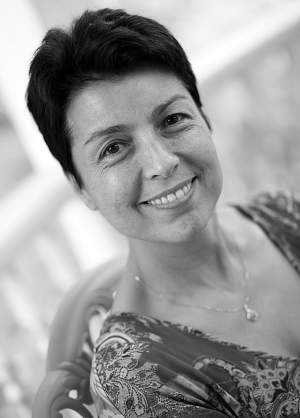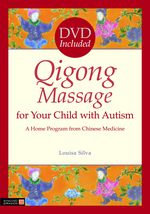 Dr Louisa Silva has a medical degree from the University of California, a Masters in Public Health from the Medical College of Wisconsin, and is a fellow of the American Academy of Medical Acupuncture. She is director of the Qigong Sensory Training Institute, Oregon, where she has completed multiple research studies into the effects of qigong massage on young children with autism.
Dr Louisa Silva has a medical degree from the University of California, a Masters in Public Health from the Medical College of Wisconsin, and is a fellow of the American Academy of Medical Acupuncture. She is director of the Qigong Sensory Training Institute, Oregon, where she has completed multiple research studies into the effects of qigong massage on young children with autism.
Here, she answers some questions about her new book and DVD, Qigong Massage for Your Child with Autism: A Home Program from Chinese Medicine.
How did you become interested in traditional Chinese approaches to health, and in working with children with autism?
I am trained in three disciplines that are of equal importance to my work: Western medicine, Chinese medicine, and public health. My interest in Chinese approaches to health began when I was in Medical school at UCLA. Nixon had gone to China, and the nation had just heard about acupuncture being done on his aide. My Medical school invited a team from China to come over, and together they did a radical mastectomy under acupuncture anesthesia. At that moment, I knew beyond a shadow of a doubt that Chinese medicine was powerful, but was too buried in my medical studies to begin to study it. It wasn’t until I had been out in practice for a few years, that I began to hit the wall with allopathic medical understanding and treatment of chronic conditions that I turned to Chinese medicine and began to study it. I found that Chinese medicine offered a way to strengthen the body so that it could throw off illness, and that it had much to offer to help improve general health and vitality. I saw the research showing that chronic conditions could be improved or cured. Over the years, I integrated what I had learned in medical school about Western diagnosis and treatment of illness, with the ancient Chinese techniques for improving health and removing illness. My interest in public health led me to pursue Chinese medical approaches to chronic illnesses that are natural, non-invasive, and easliy available to families.
My interest in autism began in 2000, when the son of a dear friend was diagnosed with autism, and I realized how little there was to offer parents of newly diagnosed children. At that point, I decided to teach a qigong massage protocol that I had learned from my Chinese medicine professor to the boy’s parents, and we found that it was helpful. This began a whole new career path for me in research, as I knew that for qigong massage to be accepted in the West as a treatment for autism, the research studies would have to be carefully done and published in scientific journals. I joined Teaching Research Institute at Western Oregon University, and now, 11 years later, we have published many research studies showing that the massage is effective, and explaining how it works.
What is Qigong Sensory Training (QST), and what are the benefits of QST for young children with autism?
Qigong Sensory Training is the name that we chose for the qigong massage methodology that is described in the book. It is a five month program of daily parent-delivered massage, and it has shown improvements in behavior and social and language skills in controlled studies. Not only does autism become less severe, but the child has general improvements in health in important areas like sleep, digestion, ability to calm themselves down, and toilet training; there is less aggressive and self-injurious behavior, and parenting stress is considerably lower.
 How did the book/DVD come about and what is the idea behind it?
How did the book/DVD come about and what is the idea behind it?
Our research suggests that behind the delays seen in children with autism lies a sensory nervous system that is out of kilter – the child’s skin, eyes and ears aren’t perceiving the world around them the way others perceive it. The senses are hypersensitive or hyposensitive or both. Many children have problems recognizing gentle touch and pain, some children don’t seem to notice when they are injured, and the senses don’t seem to work together – they don’t turn their head to look at someone’s face, and coordinate listening at the same time. Ordinary events can be confusing and upsetting for the child, and in the end, the brain doesn’t reflect accurate information about the world around them.
The hallmark of autism is a delay in social development that is apparent by age three. However, before age three, the important self-regulation milestones must be achieved for social development to proceed. The self-regulation milestones of the first three years of life are the foundation for healthy development. They are: 1) the ability to have a regular wake/sleep cycle, 2) the ability to have regular digestion and elimination, 3) the ability to self-soothe when upset, 4) the ability to regulate orientation and attention, 5) the ability to toilet train, and 6) the emerging ability to regulate emotions and behavior in response to social cues. Without these milestones, social development is delayed.
We know that all self-regulation takes place in response to sensory input. There was never a self-regulatory event that was not in response to sensory input. When sensory input is faulty, then self-regulatory output is also faulty. When sensory input is severely faulty, as it is in autism, then there is global delay of self-regulation milestones. Our research shows that children with autism have severely abnormal sensory responses, expecially of touch, and globally delayed self-regulation milestones before the age of three.
The massage works three ways: 1) it improves the circulation to the skin and normalizes touch pain responses. 2) it triggers the self-soothing response, and allows the child’s nervous system to learn to self-soothe. 3) it improves the health and vitality of the body so that digestion, elimination, toilet training and the body’s ability to remove toxins are improved. The child becomes stronger, healthier, more aware, and better able to pay attention at home and school, and to learn.
In our research, we used trained specialists to teach parents the massage, and work with them and their child over a period of months while the child overcame their barriers and difficulties with touch. We have trained a number of therapists on the East and West coast of the US, but the vast majority of the world has no trained therapists in this method. The book came about in response to many requests from parents the world over who did not have access to a trained therapist to learn the massage, and were asking for information about how to give the massage at home. It contains the full curriculum that the trained therapists impart to the parents over the months that they work with them.
Who is the book for, and how much do you have to know about TCM to use it?
This book is for families of young chldren with autism. They do not have to have a background of TCM to use it. We have explained the important ideas that they will need to use when they give qigong massage in ordinary, everyday language.
In the book you talk about the Chinese medicine explanation for the (behavioral and physiological) symptoms of autism as blockages of energy. Can you explain a bit here?
Chinese medicine considers health a state where there is abundant, free-flowing energy and circulation, and illness a state when there are blocks in the energy flow, which interfere with the free flow of the circulation. According to Chinese medicine, there is a block of the circulation to the skin, which results in the sensory nerves being over or under-sensitive. The massage normalizes the circulation and the sensation returns to normal. When the skin feels normal, many self-injurious behaviors simply disappear. The brain receives normal information about the surface of the body, and motor skills improve. For example, very quickly after sensation on the hands becomes normal, fine motor skills increase; after sensation on the feet improves, gross motor skills increase. Constipation is another example of a block of energy in the bowel, so that it does not eliminate normally. The massage quickly restores strength and energy to the bowel, and constipation resolves.
What are some challenges that parents face when attempting this kind of intervention, and how can your book help to overcome them?
At first, it can be challenging for parents to establish the massage in the child’s daily routine, as there are many parts of the body where the child is uncomfortable to touch. Often, the part of the massage that they like the least is the part where they need the most help. For example, many children with autism refuse touch on their ears. These are often the same children who do not listen or have language. Once touch on the ears becomes normal, they begin to use their ears to listen, and we see language pick up. Overcoming difficulties in particular areas is where it can be extremely helpful to have a therapist to work with. The book contains many ways to approach difficulties with touch on the different areas, as the most direct way for the child to overcome these difficulties is for the parent to continue to work with the massage. The techniques are also demonstrated on the accompanying DVD. Our program is a minimum of five months, and by the end of the first month, the majority parents have been able to help their child overcome their difficulties with touch, and both parent and child are enjoying the massage as a nice part of the daily routine.
Copyright © Singing Dragon 2011.